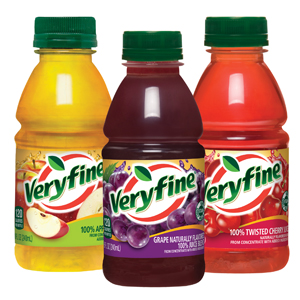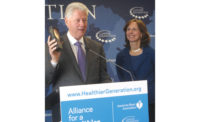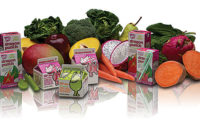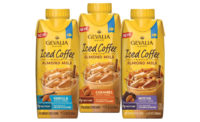
|
Earlier this year, the U.S. Department of Agriculture (USDA) released its updated Dietary Guidelines for Americans. Some guidelines in reference to beverages include reducing intake of sugar-sweetened beverages, monitoring intake of 100 percent juice for children and adolescents, and consuming soy-fortified beverages.
According to the guidelines, evidence shows that children or adolescents who consume sugar-sweetened beverages have a higher body weight than those who drink less of these types of beverages, and limited evidence suggests that increased intake of 100 percent juice has been associated with higher body weight in the same age group.
In addition to the Dietary Guidelines for Americans, the USDA also released proposed nutrition standards for school meals.
“The proposed rule requires all milk served with school meals to be 1 percent or nonfat — flavored milk must be nonfat — and juice must be 100 percent strength,” says Diane Pratt-Heavner, School Nutrition Association spokesperson. “Some schools are even working with their dairies to identify lower-sugar nonfat flavored milk varieties.”
Pratt-Heavner says the standards have not been finalized, but many schools are working to meet the proposed regulations. The expected final rule is anticipated by January 2012, she says.
Last year, it was announced that the American Beverage Association (ABA), Washington, D.C., in conjunction with the Alliance for a Healthier Generation, a joint initiative of the American Heart Association and the William J. Clinton Foundation, delivered on a three-year commitment set forth in its School Beverage Guidelines to remove full-calorie soft drinks from schools and replace them with lower calorie and smaller portioned beverages.
“One of the key aspects of the guidelines is that there’s a difference in the choices that are offered for younger students or children and older students,” says Susan Neely, president and chief executive officer of the ABA.
For example, for elementary and middle schools, beverages must be up to 8 ounces for servings of milk and 100 percent juice. Milk, flavored milk and nutritionally equivalent milk alternatives must contain up to 150 calories, while 100 percent juice must contain no added sweeteners and be up to 120 calories with at least 10 percent of the recommended daily value for three or more vitamins and minerals.
For high school age students, the guidelines include the addition of no- or low-calorie beverages with up to 10 calories in an 8-ounce serving. Serving sizes also increase to 12 ounces for milk, 100 percent juice and certain other drinks. Other drinks must contain no more than 66 calories in an 8-ounce serving. Also, at least 50 percent of non-milk beverages must be water and no- or low-calorie options.
“I find across the board what is so significant about the guidelines is they make sense to people,” Neely says. “This is not about fine-tuning a product and saying, ‘Oh, if we get rid of this it will help solve obesity.’ This is about reducing calories and doing it in a place where children are taught lots of different behaviors in their academic instruction and we also are trying to teach them good behaviors. So offering beverages to our children in schools that are either a lower-calorie variety, where there are many, many delicious choices, or offering them a smaller portion size in a beverage with calories, it just makes sense to people.”
Making changes
One brand that has redeveloped its packaging to help meet the alliance’s School Beverage Guidelines is Sunny Delight Beverage Co.’s Veryfine 100 percent juices. Veryfine now offers its juices in 5.5-ounce cans and 8-ounce PET bottles in Apple, Orange, Fruit Punch, Twisted Cherry and Grape varieties for the school beverage channel.
“As part of Sunny Delight Beverages Co., Veryfine continually adapts, innovates and grows to meet the changing tastes and needs of our consumers as well as industry experts such as the USDA and the Alliance for a Healthier Generation,” says Ed Klene, brand manager for Veryfine. “Part of this approach includes changing our products to meet the recommended guidelines in the schools, and we’re very proud that Veryfine now both meets the Alliance for a Healthier Generation and the USDA guidelines.”
Klene says updates to the products included recreating the 100 percent juices to have 120 calories or less in 8-ounce servings. The juices also are fortified with three or more vitamins and minerals, which include vitamin C, zinc and manganese, with at least 10 percent recommended daily intake without any added sugar or sweeteners.
“I think it’s a win-win for the schools, for the kids at the schools and for our company,” he says. “Our products, specifically these smaller serving sizes, provide the kids with the daily vitamins, the nutrition and the energy they need to get through the day.”
Some companies have even chosen to focus on the school channel for products versus traditional retail outlets. Richmond, Va.-based 4U2U Brands’ main focus is schools, and it formulated its Fruit 66 brand to appeal specifically to that channel.
“We created the product specifically for the USDA, the School Nutrition Association, and the Institute of Medicine [guidelines],” says Bill Hargis, president and chief executive officer for 4U2U Brands. “We went to foodservice directors and we asked them, ‘What do you need?’ The need was: ‘Get us something that’s low in calories, but get us something that tastes good.’”
Fruit 66’s 8-ounce carbonated drinks are made up of 6 ounces of 100 percent real juice and 2 ounces of sparkling water, the company says. They contain 100 percent of the daily recommended amount of vitamin C, 10 percent of the daily recommended amount of calcium and vitamins A and D, and have no added sugar, artificial flavors or colors.
Hargis says the company continues to focus on schools because it offers a product that is both low in calories and high in nutrition.
But beverage companies are not the only group that is adjusting to the school guidelines. To meet customer demands, manufacturers are now developing new products to aid beverage-makers in their desire to address the school beverage channel. Ball Corp., Broomfield, Colo., recently announced plans to manufacture an 8-ounce can in addition to the 8.4-ounce can it already offers.
“The 8-ounce trim can provides the optimal portion for kids and meets the USDA’s guidelines,” says Scott McCarty, director of corporate communications for Ball Corp. “It allows schools to continue to benefit from the 100 percent recyclability of aluminum cans.”
McCarty says the company’s close relationship with its customers and fillers brought about the 8-ounce size offering.
Offerings such as the 8-ounce can from Ball Corp. are examples of the commitment in schools to the guidelines, says ABA’s Neely.
“One of the commitments was in elementary and middle schools [where] we would have portion sizes capped at 8 ounces,” she says. “And for high school students, it’s capped at 12 ounces. That means we needed the package sizes in order to provide 100 percent juices in 8-ounce sizes if those package sizes didn’t exist. Ball Corp.’s innovation is an example of the kinds of things that have been sparked because of the commitments to the guidelines — and that’s a good thing.”
Working ahead
In addition to the new guidelines for beverages, the Healthy, Hunger-Free Kids Act requires schools to make drinking water readily available to students during lunchtime beginning with the 2011-2012 school year, School Nutrition Association’s Pratt-Heavner says.
“Schools are meeting this requirement in different ways — they can offer water pitchers and cups, a water fountain or faucet that allows students to fill their own bottles or cups,” she says.
Pratt-Heavner says the act also required the USDA to develop nutrition standards for competitive foods sold in vending machines, a la carte and school stores.
“USDA has not yet released proposed regulations for competitive foods, but schools and beverage providers are anticipating calorie and portion limits for beverages sold in schools and many schools are already limiting sugary beverage choices,” she says.
Although suggestions for stricter beverage guidelines in schools might be voiced in the future, ABA’s Neely feels confident in what the organization has accomplished with its work with the Alliance for a Healthier Generation, American Heart Association and William J. Clinton Foundation.
“Children, like grown-ups, want to enjoy lots of different flavors, tastes and different types of beverages, so to say they should only have milk, juice or water, I don’t think that’s how they’re ultimately going to live their lives and particularly when you’re talking about high school students,” she says. “I think we’re a much smarter approach to what we’ve done with the School Beverages Guidelines and offer students a broad array of choices, but again in a lower-calorie or lower-portion size choice.”
Neely has a positive outlook for beverages and the school channel.
“Since we signed the memorandum in May 2006 and completed implementation three years later, there has been a lot more innovation that’s gone on in the industry, a lot more products offered in the schools that meet the guidelines and the same products are offered in the marketplace,” she says. “I think that the future of the school market channel is a strong one. I think it will continue to be shaped by the beverage guidelines. ... We’ll continue to see lots of new products that meet the guidelines and packaging that meets the guidelines, and we’re optimistic for the school channel.” BI




